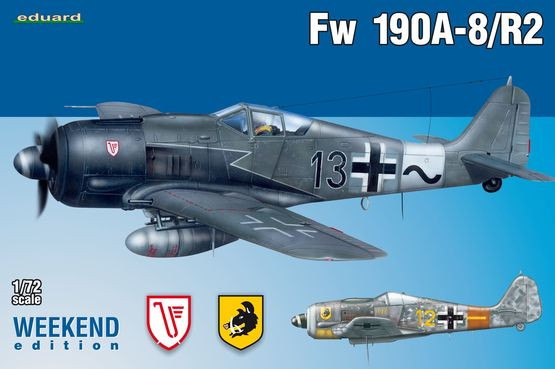
Eduard 1/72 FW190A-8/R2 Weekend
By Jacob Russell
The Plane
The Focke-Wulf FW190A-8 followed the A-7 variant into production. The A-8 incorporated the MW 50 water injection system. It provided the BMW 801-D motor a short lasting power increase to 1,440 hp at approximately 18,700 feet. The MW 50 system necessitated a cylindrical 115 liter tank in the rear fuselage. This installation required that the ventral ETC 501 rack be moved 20 cm forward. The A-8 also incorporated the strengthened wing introduced with the earlier A-6. This wing substituted MG 151s instead of MG FF cannon in the outer position.
The Rustsatze 2 (R2) variant replaced the MG 151s with a pair of 30mm MK 108 cannons with 55 rounds per gun. The R7 had additional internal and exterior armor plating. The R8 combined the armor plating of the R7 with the outboard 30mm MK 108 cannon of the R2.
The Kit
The kit comes in Eduard's customary box with a nice illustration of an A-8/R2 in flight. It consists of 128 parts on 3 sprues, one of which is clear. 44 of the parts go unused for this variant, so you will have lots of parts for the spares box.
It's worth giving special notice to the clear parts. The canopy flexed as it slid backwards on its rails and Eduard has captured this detail. Nicely done, Eduard!
The surface detail of the wings and fuselage is superb, with fine rivet detail right where it is supposed to be. The fuselage is different in that the external armor below the cockpit has been added. The wings are also modified to accurately depict the R2 variant with the outer cannon. By the way, the kit includes all of the pieces to model an R2, R7 or R8.
The ailerons and and rudder are separate pieces so you can display them displaced. The wheel wells are deep and convincingly detailed. The cockpit is shallow but it is sufficiently detailed to look the part.
You get 2 styles of tires, smooth and ribbed, plus the early (perforated) and late (smooth) wheel faces. There are 2 propellers included, one of which is the wide blade, wooden VDM 9-12157H3, which is applicable to the later A-9 variant. There's an ETC 50 rack plus a drop tank and an SC 250 bomb. The BMW 801-D is well molded but it will be all but invisible behind the prominent 12 blade cooling fan and propeller.
There are 2 well printed decal sheets, one of which is devoted to airframe stencils. The main decal sheet includes a pair of instrument panel faces and a set of seat belts. The decals are up to Eduard's usual standards. They are well printed, legible, and in register. There are 2 decal options in the kit, both of which are painted in the standard mid-War Luftwaffe colors of RLM 74/75/76:
1) "Black 13", Werner Gurth, II. (Sturm)/JG 3 "Udet", July 1944. This plane had an all black cowl and stylized black panes aft of the exhaust panels. The spinner was black with a white spiral. There was also a white fuselage band. The fuselage was heavily overpainted with RLM 74 and 75. There was a large area of RLM 76 with the Balkankreuz on top of it.

2) "Yellow 13", Paul Lixfield, 6./JG300. This plane had an RLM 04 yellow lower cowl, and a rust red fuselage band. The spinner was RLM 70 with a white spinner.
The instructions follow Eduard's standard format, with a parts map and a well illustrated, logical build sequence. Color callouts are for Gunze Mr. Color paints.
Conclusion
Just about every manufacturer has tried their hand at the radial engine Focke-Wulf FW190. Hasegawa led the field for many years with their 1/72nd kits. Airfix recently introduced FW190A-8 and F-8 kits that have more accurate wheel wells and better detailed cockpits than Hasegawa's.
The new Eduard kits are a decided cut above the rest. They are accurate and well detailed. They look good right out of the box, and if so inclined you can go to town with Eduard's photo etched sets and Brassin detail parts. I recommend this kit and I would like to thank Eduard for providing the review sample.
References
Focke-Wulf FW190, Volume I, by Krzysztof Janowicz, Kagero Publications, 2003
FW-190 in action, Aircraft Number 170, by Brian Filley, Squadron/Signal Publications, 1999

